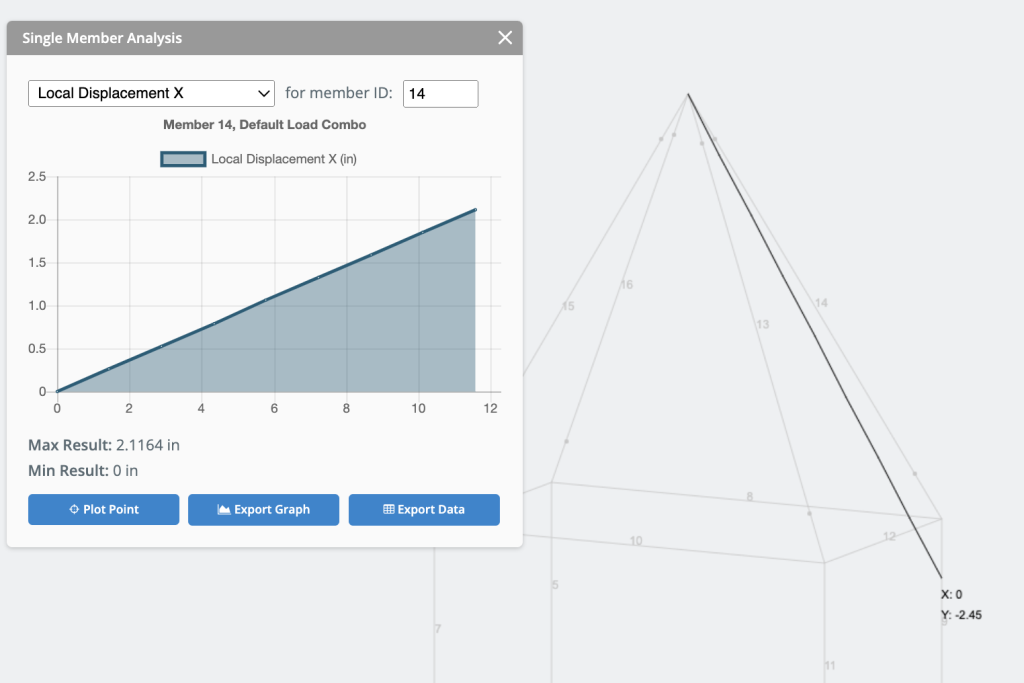建模钢架
让我们从建立一个简单的框架开始, 这将是我们使用电缆元素提起的. 我们将充分利用以下方便的建模功能:
- 笔工具 – 使用钢笔工具快速建模
- 多重编辑 – 按住 CTRL 并拖动鼠标以选择和多重编辑模型的部分
- 搜索栏目 – 在几秒钟内快速从我们的库中添加部分, 使用搜索
- 区域负荷 – 单程, 自动计算的双向和风荷载面积荷载 (并重新调整!) 成员的朝贡地区.

添加您的电缆元素
所以现在我们添加电缆. 电缆是非线性元素, 所以基本上添加方式与添加任何其他成员相同. 主要区别在于电缆永远不会受到压缩, 具有零弯曲, 扭转或剪切能力 (他们只是紧张) 它们经常表现出大位移和非线性行为. 因此,分析这些类型的单元的处理方式与具有弯曲和其他强度的常规钢单元略有不同.
电缆元件的建模方式与任何其他元件的建模方式相同. 然而, 当你分配属性时, 你会选择 类型: 电缆. 这将自动为单元分配固定端固定装置,并将其视为解算器中的电缆单元.

打开渲染器视图, 清楚地显示电缆元件 (在这个模型中, 表示为部分 ID 2).
应用设备和其他负载
将设备载荷应用于框架结构与常规分析模型相同. 在这种情况下,我们施加了设备负载 (使用 双向面积荷载) 和其他一些静载 (使用 单向面积荷载).

进行非线性分析和修复稳定性问题
承受重大负载时,电缆通常会发生大变形. 几何非线性考虑了电缆几何变形时的变化. 电缆响应中线性的最初假设 (如线性静态分析) 当变形变得重要时,变形无效.
存在电缆元件时,有必要使用非线性分析, 因为非线性分析考虑了这些几何变化并提供了更准确的结果. 当您加载或拉紧电缆时, 每一步之后,结构都发生了很大的移动,以至于载荷不一定施加在与之前相同的位置.
因此, 对于这个结构,我们需要执行非线性分析. 注意: 如果用户选择 线性静态分析, 它会自动恢复到非线性分析.

审查结果
一旦分析成功完成, 检查偏转是一个好主意 (一个) 确保数字合理,并且 (b) 动画结构的挠度,以查看它是否以您期望的方式变形. 如果电缆元素无法正确求解, 您会看到锯齿状的挠度曲线,并且可能表明电缆在或超载下载.
表现良好的电缆元素应该平稳, 下垂并显示仅张力的变形, 如示例模型所示:

另一个值得回顾的结果, 是索腱中的轴向应力. 明显, 因为电缆没有剪切或弯曲能力, 所有的力都通过元件中的张力传递. 默认情况下,结构将突出显示超过材料屈服/极限强度的任何应力. 您还可以输入您自己的自定义许用应力, 以便您可以轻松识别超出压力限制的元素:

值得考虑的另一个结果是电缆中的伸长率. 与先前审查的变形结果相似, 但是,在这种情况下,我们正在研究电缆已伸展多远. 设计电缆通常可以接受的限制. 位移分析有助于评估电缆在不同的负载条件下的行为,并确保位移在允许的范围内.
为了这, 我们可以使用单一成员分析并打开 局部位移 X 这将为我们提供电缆沿其自身轴线的总偏转. 在下面的例子中, 电缆被拉长 2.1164 英寸:

电缆分析中的共同解决问题
如果您的电缆结构未能解决 (很多时候由于不稳定或无法收敛), 以下是一些需要检查或尝试的常见事项:
- 检查直径尺寸
- 检查电缆是否过载/不足
- 降低收敛精度
- 添加额外的支持
- 检查您的其他会员
常问问题
电缆下垂是通过考虑电缆的自重和所施加的负载来解释的, 这会导致挠度. 工程师通常使用链式方程或数值方法来确定电缆的形状和在特定的加载条件下的下垂.
是的, 您可以将预应力负载施加到电缆元件
是的, 但是,该软件将自动为您处理此操作. 在其他软件中, 电缆元件可以分成更小的元件, 调整起来可能很麻烦. SkyCiv 将保留该元素作为单一成员, 并且只在解算器一侧分割元素 – 使建模和更改变得更容易.


